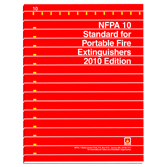
NFPA 10: Fire Extinguisher Tests, Inspections & Maintenance in San Marcos
NFPA 101(00), Sec. 9.7.4.1 require that portable fire extinguishers be inspected and maintained in accordance with NFPA 10, Standard for Portable Fire Extinguishers. NFPA 101(00), Sec. 2.1.1 references the 1998 edition of NFPA 10.

Visit NFPA to purchase the newest version of the NFPA 10 standards and codes.
San Marcos Portable Fire Extinguisher Visual Inspections
Portable fire extinguishers are required to be visually inspected when initially placed in service and at least monthly thereafter [see NFPA 10(98), Sections 4-3.1]. These visual inspections, intended to help ensure that each extinguisher is in its designated place and will operate if needed, can be performed by facility staff.
A pressure gauge in the “normal” or “operable” range is not a 100 percent guaranty that the extinguisher will perform as intended. A broken seal, for example, may be an indication that someone has used the extinguisher and discharged a portion of the contents too small to affect the pressure gauge. NFPA 10(98), Sec. 4-3.2, therefore, requires that the monthly inspection verify a number of things including:
- Extinguishers are in their designated places
- There are no obstructions to access or visibility
- Safety seals are not broken or missing
- There is no evidence of physical damage, corrosion, leakage or clogged nozzle
- Pressure gauge readings are in the proper range or position
- Operating instructions are legible and facing outward
- Fullness – confirmed by weighing or lifting
- Where circumstances warrant, some fire extinguishers may have to be inspected more frequently.
Examples of such circumstances might include extinguishers that are oftentimes found obstructed during monthly inspections or extinguishers located in areas where they are subject to tampering, theft or mechanical injury. Obviously, any problems found during the monthly inspection must be corrected immediately. Some problems trigger a need for full maintenance or even replacement of the extinguisher. For example:
- Full maintenance procedures must be performed whenever an inspection of a rechargeable fire extinguisher reveals any of the following problems [see NFPA 10(98), Sec. 4-3.3.1]:
- Operating instructions are not legible
- Safety seals are broken or missing
- Fullness can’t be confirmed (as determined by weighing or lifting)
- There is evidence of physical damage, corrosion, leakage or a clogged nozzle
- Pressure gauge readings are not in the operable range or position
- When any of the conditions noted in Item 1 on the previous page, with the exception of a broken or missing safety seal, are found during an inspection of a non-rechargeable dry chemical extinguisher, the extinguisher must be removed from use [see NFPA 10(98), Sec. 4-3.3.2].
- Non rechargeable extinguishers can be identified by looking for markings similar to the following: “Discharge and Dispose of After Any Use”, “Discharge and Return to Manufacturer After Any Use”, or simply “Non-rechargeable”.
San Marcos Portable Fire Extinguisher Annual Tests, Inspections and Maintenance
“Maintenance” is a thorough examination and repair, as needed, of your facility’s portable fire extinguishers and is covered in NFPA 10(98), Sec. 4-4. Maintenance is required at least once a year – more frequently when indicated by a routine monthly inspection, as discussed earlier. Maintenance is also required whenever extinguishers undergo hydrostatic testing. Because maintenance is required to include a thorough examination of the mechanical parts, extinguishing agent and expelling means of each portable fire extinguisher, it must be performed by an approved extinguisher servicing company. A more detailed look at what annual maintenance entails can be found in NFPA 10(98), Tables A-4-4.4.2(a) and A-4-4.4.2(b). It should be noted that new tamper seals are required to be installed whenever maintenance is performed on rechargeable fire extinguishers [see NFPA 10(98), Sec. 4-4.2.1].
San Marcos Portable Fire Extinguisher Six (6) Year Tests, Inspections and Maintenance
Every 6 years, stored pressure fire extinguishers that require a 12-year hydrostatic test (e.g. dry chemical extinguishers) must be emptied and proper maintenance procedures performed [see NFPA 10(98), Sec. 4-4.3]. The exception to this rule is non-rechargeable extinguishers, which are required to be removed from service 12 years from the date of manufacture. Again, this maintenance must be performed by an approved extinguisher servicing company.
San Marcos Portable Fire Extinguisher Hydrostatic Tests, Inspections and Maintenance
At certain intervals, fire extinguishers are required to be pressure tested using water or some other non-compressible fluid to help prevent unwanted failure or rupture of the cylinder [see NFPA 10(98), Chapter 5]. This is called hydrostatic testing and includes both an internal and external examination of the cylinder. Because this testing requires special training and equipment, it needs to be performed by an approved extinguisher servicing company.
Hydrostatic testing intervals for fire extinguishers are outlined in NFPA 10(98), Sec. 5-2 and Table 5-2. Test intervals for some of the most commonly found extinguishers are as follows:
- Pressurized water, carbon dioxide and wet chemical extinguishers – every 5 years
- Dry chemical extinguishers – every 12 years
As mentioned earlier, the exception to the rule for hydrostatic testing is no rechargeable stored pressure extinguishers (e.g. dry chemical extinguishers), which are required to be removed from service 12 years from the date of manufacture.
Information only:
Some of you may have heard…
The 2007 edition of NFPA 10 contains a new requirement for the removal of dry chemical extinguishers manufactured prior to October, 1984 [see NFPA 10(07), Sec. 4.4.1]. Removal is to occur at the time of the next 6-year maintenance interval or next hydro test interval, whichever comes first. This requirement came about as the result of significant changes made to UL Standard 299, Dry Chemical Fire Extinguishers, based on fire testing conducted by UL, FEMA and NFPA.
Documentation Requirements
Almost as important as conducting required inspection, testing and maintenance is documenting the fact that it occurred. NFPA 10 requires that these services be properly recorded.
San Marcos Hydrostatic Tests and Inspections
All commercial and industrial business owners shall assure that hydrostatic testing is performed by trained persons with suitable testing equipment and facilities. The commercial and industrial business owners shall assure that portable extinguishers are hydrostatically tested at the intervals listed in Table L-1 of this section, except under any of the following conditions:
- When the unit has been repaired by soldering, welding, brazing, or use of patching compounds
- When the cylinder or shell threads are damaged
- When there is corrosion that has caused pitting, including corrosion under removable name plate assemblies
- When the extinguisher has been burned in a fire
- When a calcium chloride extinguishing agent has been used in a stainless steel shell.
In addition to an external visual examination, the commercial and industrial business owners shall assure that an internal examination of cylinders and shells to be tested is made prior to the hydrostatic tests. In addition to an external visual examination, the commercial and industrial business owners shall assure that an internal examination of cylinders and shells to be tested is made prior to the hydrostatic tests. OSHA (Occupational Safety and Health Standards) Fire Protection: Portable fire extinguishers
TABLE L-1
Type of extinguishers |
Test interval (years) |
Soda acid (soldered brass shells) (until 1/1/82) |
(1) |
1) Extinguishers having shells constructed of copper or brass joined by soft solder or rivets shall not be hydrostatically tested and shall be removed from service by January 1, 1982. (Not permitted)






